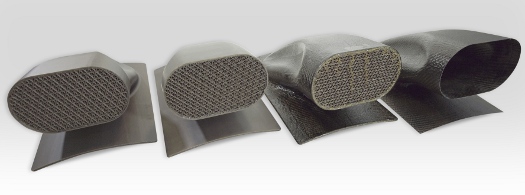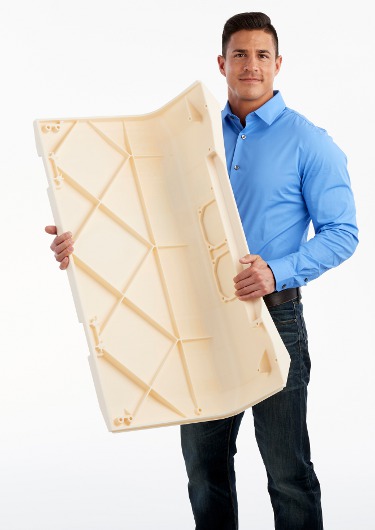 |
| August 01, 2017 | Volume 13 Issue 29 |
Designfax weekly eMagazine
Archives
Partners
Manufacturing Center
Product Spotlight
Modern Applications News
Metalworking Ideas For
Today's Job Shops
Tooling and Production
Strategies for large
metalworking plants
3D Printing:
Sacrificial tool simplifies production of hollow composite parts
New FDM 3D printer enhancements make stratasys solutions stronger, simpler, and faster for demanding industrial applications.

Sacrificial tool used to create a hollow inlet duct by Swift Engineering using Stratasys' new ST-130 material.
Sometimes 3D printing needs extra built-in technologies or final finishing work to get the job done. Dissolvable sacrificial materials provide a great option. Stratasys has introduced four new enhancements to Stratasys Fused Deposition Modelling (FDM)-based 3D printers, fully optimizing select models for creating functional product prototypes, production tools, and end-use parts for the most demanding manufacturing applications.
Sacrificial tooling, a process in which 3D-printed molds are wrapped in composite material and then removed after part curing, enables manufacturers to rapidly and cost-effectively create complex, hollow composite parts. Stratasys is improving this process with a new sacrificial tooling solution, comprised of its new ST-130 material and new fill patterns. Together, the new material and fill patterns provide faster dissolution, rapid build speed, better autoclave performance, and greatly improved tool quality.
Complex tools can be 3D printed and easily dissolved after curing, eliminating secondary processes like mold making while accelerating your composite lay-up work. ST-130 withstands the heat and pressure of autoclave curing, and it 3D prints with a permeable triangle fill pattern to cut build time, conserve material, and dissolve quickly.
The sacrificial tooling solution is available for the Fortus 450mc and 900mc 3D Printers.
"Ideal for automotive, aerospace, and sporting goods industries, the new ST-130 material empowers manufacturers of composite parts with an accelerated, more cost-effective option for sacrificial tooling," said Ryan Sybrant, director, Manufacturing Marketing and Enablement at Stratasys.

The Fortus 900mc Acceleration Kit reduces time and cost for 3D printing large parts in ASA and ULTEM 1010 materials.
To reduce production time and cost for both parts and tooling, Stratasys has created the Fortus 900mc Acceleration Kit. This kit, designed for Stratasys' most powerful FDM 3D printer, allows very large structures to be 3D printed up to three times faster. The kit is compatible with ASA and ULTEM 1010 materials.
RELATED STRATASYS DEVELOPMENTS
ULTEM 9085 Aerospace: First ULTEM material with full aerospace traceability
Aerospace engineers and manufacturers require materials with precise specifications and traceability for prototypes and end-user parts. Stratasys ULTEM 9085 Aerospace-grade filaments are produced according to aerospace specification requirements. While there is no change from the standard ULTEM 9085 material, the new Aerospace designation allows for full production traceability in compliance with strict aerospace requirements. In addition to the Stratasys Certificate of Compliance, each order of ULTEM 9085 Aerospace-grade filament is provided with traceability documentation and a certificate of analysis confirming batch material properties.
In the big picture, this means that engineers can begin prototyping sooner, avoiding lengthy time to market for new aerospace designs and high costs resulting from late-development design changes. ULTEM 9085 Aerospace is also optimized for low-volume or custom tooling applications.
Tough PC-ABS material available on more Stratasys 3D printers
With its high durability and smooth matte finish, PC-ABS is a natural choice for challenging applications, such as power-tool prototyping and industrial equipment manufacturing. Owners of the Fortus 380mc and 450mc 3D Printers will now have the ability to leverage PC-ABS, reducing time to market and high tooling costs for low-volume and custom production builds. 3D printing in real engineering thermoplastics results in stronger parts, more confident testing, and prototypes that mimic the material properties of the final product.
Source: Stratasys
Published August 2017
Rate this article
View our terms of use and privacy policy
